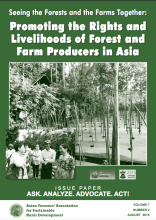Land Library Search
Through our robust search engine, you can search for any item of the over 73,000 highly curated resources in the Land Library.
If you would like to find an overview of what is possible, feel free to peruse the Search Guide.
/ library resources
Showing items 1 through 9 of 10.Building on the current international discourse and United Nation's System of Environmental-Economic Accounting (SEEA) this study provides further empirical evidences on how failure to include natural capital resources in national accounting leads to erroneous calculation of macroeconomic estimat
The presented paper synthesizes and reviews the history of Fist Nation land management, forming the background of three land management regimes types; the Indian Act land management (IALM), First Nations land management (FNLM) and frameworks of self-government land management (SGLM).
Whereas ecosystem service research is increasingly being promoted in science and policy, the utilisation of ecosystem services knowledge remains largely underexplored for regional ecosystem management.
Evidence-based policy guidance necessary for addressing mixed outcomes of community-based rangeland management (CBRM) is limited, dominated by case studies, and lacking coverage of diverse ecological settings.
Most stakeholder-based research concerning agri-environmental schemes (AES) derives from work engaging with farmers and land managers. Consequently, the voices and opinions of other actors involved in AES tends to be unrepresented in the wider literature.
Societal drivers including poverty eradication, gender equality, indigenous recognition, adequate housing, sustainable agriculture, food security, climate change response, and good governance, influence contemporary land administration design.
Globally, there is growing demand for increased agricultural outputs. At the same time, the agricultural industry is expected to meet increasingly stringent environmental targets. Thus, there is an urgent pressure on the soil resource to deliver multiple functions simultaneously.
There is a very close relationship between forestry and farming. Both forests and farms are source of food (both from plants and animals), nutrition, health, and livelihoods for family farmers. Besides, forests provide sources for fuel, energy, water and medicines.
WHAT IS MEANT BY AGRIBUSINESS?



